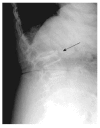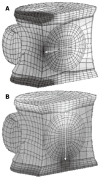Methods of predicting vertebral body fractures of the lumbar spine
- PMID: 24147259
- PMCID: PMC3801243
- DOI: 10.5312/wjo.v4.i4.241
Methods of predicting vertebral body fractures of the lumbar spine
Abstract
Lumbar vertebral body (VB) fractures are increasingly common in an ageing population that is at greater risk of osteoporosis and metastasis. This review aims to identify different models, as alternatives to bone mineral density (BMD), which may be applied in order to predict VB failure load and fracture risk. The most representative models are those that take account of normal spinal kinetics and assess the contribution of the cortical shell to vertebral strength. Overall, predictive models for VB fracture risk should encompass a range of important parameters including BMD, geometric measures and patient-specific factors. As interventions like vertebroplasty increase in popularity for VB fracture treatment and prevention, such models are likely to play a significant role in the clinical decision-making process. More biomechanical research is required, however, to reduce the risks of post-operative adjacent VB fractures.
Keywords: Bone mineral density; Fracture; Lumbar spine; Model; Osteoporosis; Prediction; Vertebral body.
Figures





Similar articles
-
Biomechanical effects of metastasis in the osteoporotic lumbar spine: A Finite Element Analysis.BMC Musculoskelet Disord. 2018 Feb 5;19(1):38. doi: 10.1186/s12891-018-1953-6. BMC Musculoskelet Disord. 2018. PMID: 29402261 Free PMC article.
-
[Influence on adjacent lumbar bone density after strengthening of T12, L1 segment vertebral osteoporotic compression fracture by percutaneous vertebroplasty and percutaneous kyphoplasty].Zhongguo Xiu Fu Chong Jian Wai Ke Za Zhi. 2013 Jul;27(7):819-23. Zhongguo Xiu Fu Chong Jian Wai Ke Za Zhi. 2013. PMID: 24063170 Chinese.
-
Contribution of the cortical shell of vertebrae to mechanical behaviour of the lumbar vertebrae with implications for predicting fracture risk.Br J Radiol. 1998 Jul;71(847):759-65. doi: 10.1259/bjr.71.847.9771387. Br J Radiol. 1998. PMID: 9771387
-
Analysis of recurrent fracture of a new vertebral body after percutaneous vertebroplasty in patients with osteoporosis.Orthop Surg. 2010 May;2(2):119-23. doi: 10.1111/j.1757-7861.2010.00074.x. Orthop Surg. 2010. PMID: 22009926 Free PMC article.
-
Influence of Prevalent Vertebral Fracture on the Correlation between Change in Lumbar Spine Bone Mineral Density and Risk of New Vertebral Fracture: A Meta-Analysis of Randomized Clinical Trials.Clin Drug Investig. 2020 Jan;40(1):15-23. doi: 10.1007/s40261-019-00868-4. Clin Drug Investig. 2020. PMID: 31630338
Cited by
-
Relationship between sagittal spinal alignment and the incidence of vertebral fracture in menopausal women with osteoporosis: a multicenter longitudinal follow-up study.Eur Spine J. 2015 Apr;24(4):737-43. doi: 10.1007/s00586-014-3637-8. Epub 2014 Nov 6. Eur Spine J. 2015. PMID: 25374300
-
Effects of Leisure-Time Physical Activity on Vertebral Dimensions in the Northern Finland Birth Cohort 1966.Sci Rep. 2016 Jun 10;6:27844. doi: 10.1038/srep27844. Sci Rep. 2016. PMID: 27282350 Free PMC article.
-
High-impact exercise in adulthood and vertebral dimensions in midlife - the Northern Finland Birth Cohort 1966 study.BMC Musculoskelet Disord. 2017 Nov 6;18(1):433. doi: 10.1186/s12891-017-1794-8. BMC Musculoskelet Disord. 2017. PMID: 29110646 Free PMC article.
-
Predictive factors for conversion from conservatively to surgically treatment osteoporotic thoracolumbar compression fractures based on sagittal parameters and magnetic resonance imaging features.Eur Spine J. 2023 Nov;32(11):3933-3940. doi: 10.1007/s00586-023-07864-5. Epub 2023 Jul 26. Eur Spine J. 2023. PMID: 37493855
References
-
- Bouxsein ML, Melton LJ, Riggs BL, Muller J, Atkinson EJ, Oberg AL, Robb RA, Camp JJ, Rouleau PA, McCollough CH, et al. Age- and sex-specific differences in the factor of risk for vertebral fracture: a population-based study using QCT. J Bone Miner Res. 2006;21:1475–1482. - PubMed
-
- Andresen R, Werner HJ, Schober HC. Contribution of the cortical shell of vertebrae to mechanical behaviour of the lumbar vertebrae with implications for predicting fracture risk. Br J Radiol. 1998;71:759–765. - PubMed
-
- Baroud G, Vant C, Wilcox R. Long-term effects of vertebroplasty: adjacent vertebral fractures. J Long Term Eff Med Implants. 2006;16:265–280. - PubMed
-
- Augat P, Reeb H, Claes LE. Prediction of fracture load at different skeletal sites by geometric properties of the cortical shell. J Bone Miner Res. 1996;11:1356–1363. - PubMed
-
- Melton LJ, Riggs BL, Keaveny TM, Achenbach SJ, Hoffmann PF, Camp JJ, Rouleau PA, Bouxsein ML, Amin S, Atkinson EJ, et al. Structural determinants of vertebral fracture risk. J Bone Miner Res. 2007;22:1885–1892. - PubMed
Publication types
LinkOut - more resources
Full Text Sources
Other Literature Sources
Research Materials

